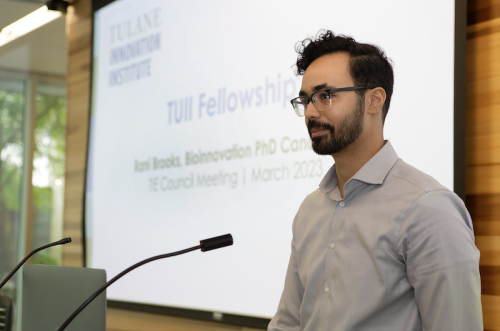Founder Story:
Rani Brooks, Founder, BioPhoundry
Alan Colowick Innovation Postdoctoral Fellow at the Tulane Innovation Institute

Rani Brooks, BioInnovation, PhD, is the Alan Colowick Innovation Postdoctoral Fellow at the Tulane Innovation Institute. Rani supports the Institute in expanding its commercialization efforts while also dedicating attention to his own venture, BioPhoundry. BioPhoundry is a biotech company that utilizes phage therapy to combat antimicrobial-resistant (AMR) infections. Inspired by the effectiveness of phage therapy, despite the bottlenecks in the drug discovery and manufacturing process, Rani aims to create a solution to make phage therapy more scalable and reach more patients.
He embarked on his scientific journey at the Walter Reed Army Institute of Research (WRAIR) through the Science and Engineering Apprenticeship Program (SEAP) for high school students. Hailing from Virginia, Rani earned a BSc in Biological Sciences with a Microbiology concentration at Cornell University. Following his academic pursuits, Rani was the Biochemistry Lead at Zymtronix Catalytic Systems, a Cornell spinout. There, he contributed to developing magnetic immobilized enzymes to reduce the production costs of high-value small molecules.
Driven by an entrepreneurial spirit, Rani joined Tulane's interdisciplinary BioInnovation PhD Program as a National Science Foundation Integrative Graduate Education and Research Traineeship Fellow to develop a translatable technology for creating personalized medicines to address AMR infections.
Upon completing his PhD in 2023, Rani joined the Tulane Innovation Institute to advance his personalized medicine research and bring it to market through his venture, BioPhoundry, LLC. BioPhoundry is dedicated to curing AMR infections by developing precision antibiotics on demand.
What made you want to explore phage therapy in your research?
In 2012, I read a one-page Scientific American editorial on phage therapy. It described phage therapy’s long history, which started in the 1920s, preceding the discovery of penicillin by decades. As a Microbiology major, I thought it was an amazing way to treat infections. I wanted to understand why phage therapy fell out of fashion and why it’s not used more to treat AMR infections today. It turned out that phage therapy is safe and effective but slow and expensive due to bottlenecks in the drug discovery and manufacturing process. Inspired by that problem and my post-undergrad job at a biotech startup, I wanted to create a solution to uncork those bottlenecks to make phage therapy more scalable to reach more patients. Tulane’s unique interdisciplinary Bioinnovation PhD program allowed me to “choose my own adventure” and plan a personalized PhD track. I used my time in the program to develop tools to overcome these challenges and start BioPhoundry.
What advice would you provide to researchers interested in commercializing their technology?
I have three pieces of advice. First, talk to people in your target audience to determine if your tech can be packaged as a product that solves a problem and that people would be willing to pay for that solution. Second, find a teammate. Having someone in the trenches with you can help when encountering inevitable hurdles. My teammate, Sahan Liyanagedera, PhD, has supported the daily work of launching BioPhoundry and has also been a critical source of morale when times get tough. My last piece of advice is to use LinkedIn. This might sound boring, but LinkedIn is a great way to connect with people and keep tabs on your industry. It has been an invaluable tool for tracking key opinion leaders, regulatory trends, and the ups/downs of tech investment. The first thing I do each morning is open LinkedIn to catch up on the industry zeitgeist.
How has your fellowship with the Tulane Innovation Institute helped you with the development of BioPhoundry?
The greatest gift has been time. I had done a lot of work during my PhD to lay the foundations for BioPhoundry, but there were limits to what I could achieve with the business when I spent most of my time in the lab. The fellowship has also given me the much-needed runway to focus on strategic planning, team building, and fundraising.
How did your GWIN Mentorship help you with research and entrepreneurship development?
My mentor team (Giffen Weinmann, Jeremy Reinmann, and John Paolini) has been very helpful as a sounding board for business planning and advice built on real-world know-how. You can read all the entrepreneurship books in the world, but nothing beats working with experienced folks who’ve “been there and done that.”

Rani Brooks and BioPhoundry are pushing the boundaries of biotech and phage therapy to solve some of the world’s most pressing health issues and inspire a new generation of scientists and entrepreneurs to approach problems with a different mindset.
